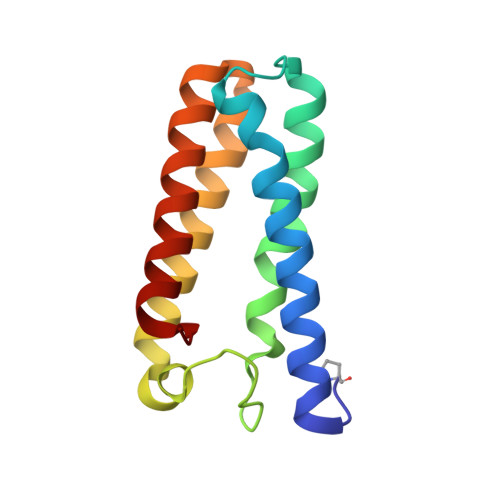Engineering proximal vs. distal heme-NO coordination via dinitrosyl dynamics: implications for NO sensor design.
Kekilli, D., Petersen, C.A., Pixton, D.A., Ghafoor, D.D., Abdullah, G.H., Dworkowski, F.S.N., Wilson, M.T., Heyes, D.J., Hardman, S.J.O., Murphy, L.M., Strange, R.W., Scrutton, N.S., Andrew, C.R., Hough, M.A.(2017) Chem Sci 8: 1986-1994
- PubMed: 28451315
- DOI: https://doi.org/10.1039/c6sc04190f
- Primary Citation of Related Structures:
5JLI, 5JP7, 5JRA, 5JS5, 5JSL, 5JT4, 5JUA, 5JVE - PubMed Abstract:
Proximal vs. distal heme-NO coordination is a novel strategy for selective gas response in heme-based NO-sensors. In the case of Alcaligenes xylosoxidans cytochrome c' (AXCP), formation of a transient distal 6cNO complex is followed by scission of the trans Fe-His bond and conversion to a proximal 5cNO product via a putative dinitrosyl species. Here we show that replacement of the AXCP distal Leu16 residue with smaller or similar sized residues (Ala, Val or Ile) traps the distal 6cNO complex, whereas Leu or Phe residues lead to a proximal 5cNO product with a transient or non-detectable distal 6cNO precursor. Crystallographic, spectroscopic, and kinetic measurements of 6cNO AXCP complexes show that increased distal steric hindrance leads to distortion of the Fe-N-O angle and flipping of the heme 7-propionate. However, it is the kinetic parameters of the distal NO ligand that determine whether 6cNO or proximal 5cNO end products are formed. Our data support a 'balance of affinities' mechanism in which proximal 5cNO coordination depends on relatively rapid release of the distal NO from the dinitrosyl precursor. This mechanism, which is applicable to other proteins that form transient dinitrosyls, represents a novel strategy for 5cNO formation that does not rely on an inherently weak Fe-His bond. Our data suggest a general means of engineering selective gas response into biologically-derived gas sensors in synthetic biology.
Organizational Affiliation:
School of Biological Sciences , University of Essex , Wivenhoe Park , Colchester , Essex CO4 3SQ , UK . Email: mahough@essex.ac.uk.

















